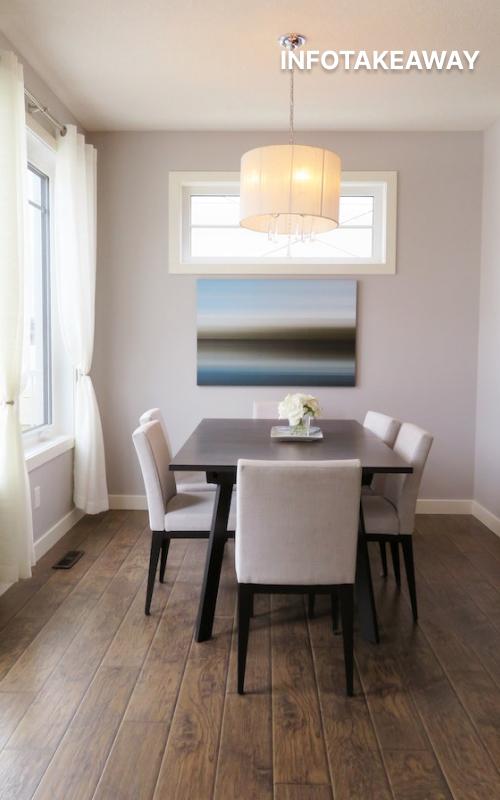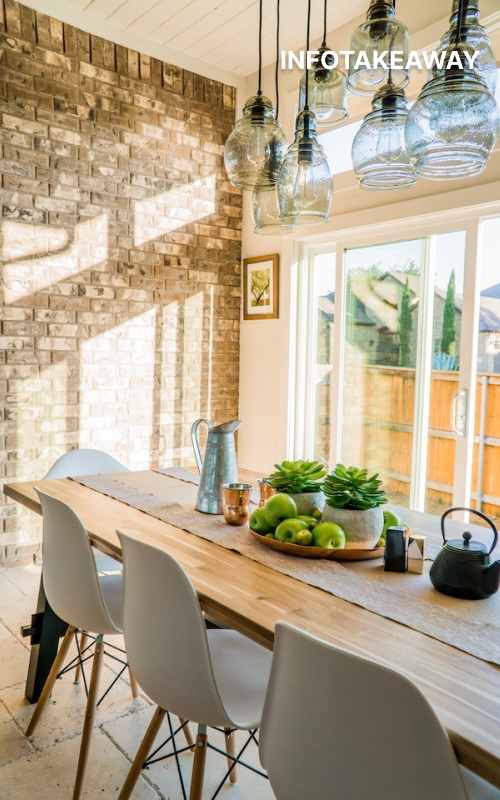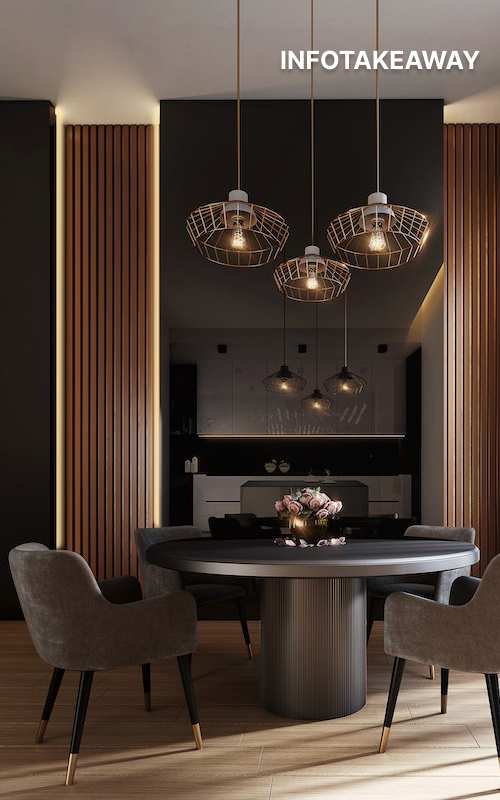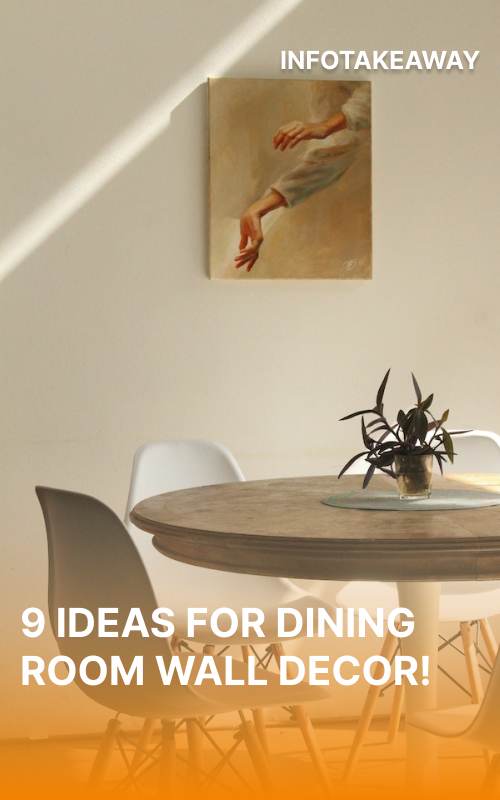For many people, dining room walls are often just flat painted with minimal flair and little detail. But, this doesn’t have to be the case!
Incorporating amazing dining room wall decor into your home can completely transform the look of your space. Here are our 9 tips!
1) One main focal point
There’s a reason that dining rooms are often the most beautiful, luxurious, and well-decorated rooms in a home. It is where guests are first welcomed into your home, after all!
As such, it’s important to make sure you’re giving them an excellent first impression by incorporating some amazing dining room wall decor. Fortunately, there are plenty of great ways to do this.
Here are some of our favorites:
- Start with one main focal point: Is your eye drawn straight to the chandelier or those gorgeous paintings? You may want to place other items strategically around these focal points so they can work as showstoppers without overpowering them.
- Add something extra: Tapestries on either side of a fireplace mantel instantly liven up a living space. Similarly, it’s easy to add drama with mirrors and artwork opposite each other on adjacent walls – the effect creates depth and dimension in the space.
- Hang curtains from floor to ceiling: Curtains cover any holes or ugly spots on your walls, making for a unified look. In addition, they create more intimate and private spaces within the room.
- Use wallpaper creatively: Even if you don’t have enough money for new paint or furniture, adding a little wallpaper will go a long way towards creating an updated look in any part of the house.
2) Two accent walls
Accent walls are a great way to add color and interest to a home. They can be used in any room, but they’re especially useful in dining rooms because the feature is often the focal point of the room.

This is one of my favorite dining room accent wall ideas: just paint a few sections of your accent wall in different colors!
You could do green and blue for an ocean-themed dining room or red, orange, and yellow for a sunset-inspired space.
Another idea is to choose colors that coordinate with your dinnerware. I love this look with white table linens; it’s so chic!
If you want something a little more subtle, try painting two panels next to each other and then adding another panel in between them.
Another awesome thing about accent walls? They can be changed out as often as you want! That means if you get bored of blue and green oceans, you could change it up by adding pink flowers to the opposite side of your room.
That same goes for all colors, whether they’re from your dinnerware set or not. So go ahead—get creative! The possibilities are endless!
3) Patterned wallpaper
Patterned wallpaper is a great way to create a high-end feel in your dining room. But it’s not just about the aesthetics of the pattern, but how it fits with the surrounding decor.
Here are 9 tips for incorporating amazing dining room wall decor into your home:
- Avoid placing it over furniture or other wall coverings.
- Make sure that the width and height of the pattern match the wall’s proportions.
- Experiment with different patterns to see which one you like best by pasting small pieces of paper with different patterns on them onto your walls.
- A large pattern can overwhelm a small room while a small pattern can make an oversized space look empty.
- Remember that white paint has no texture so take this into account when choosing textured wallpaper.
- Paint might be the better option if you want to change your wall color frequently and it doesn’t matter if there’s texture on the surface.
- If you’re going to use decorative elements (like molding), they should either have some relation to the design of the wallpaper or complement it instead of competing with it.
- Walls should be at least 3⁄4 inches thick for a successful installation.
- Use heavy-duty adhesives since this type of wallpaper can be difficult to remove from porous surfaces such as plasterboard without causing damage.
- If you do choose to place it over furniture or other wall coverings, know that its color may clash with the fabric on these items.
- Match the width and height of the pattern to suit your wall’s proportions; don’t let one overpower the other!
- When testing out different designs, remember that if you stick it on a piece of cardboard, and paste little bits of differently designed papers all over until you find something that stands out.
- Painting is usually easier than taking down old wallpaper, changing colors often will suffice.
4) Coordinated mirrors
Mirrors are a great way to create the illusion of more space. They also help bounce light, which can make a room feel brighter.
Mirrors can be used as furniture like an accent table or they can be hung on the wall and used as art.
- Mirrors are perfect for adding that little something extra to your dining room wall decor. Coordinate mirrors with one another to help create symmetry in the design scheme.
- Choose small square mirrors for shelves instead of large rectangular mirrors. Large rectangular mirrors will dwarf your display items and look heavy on small shelves. Square mirrors provide just enough reflection without taking up too much visual real estate.
- Add geometric patterns by hanging small frames containing various shapes near each other on the wall – try using squares, circles, triangles, and rectangles together. You can even use them to form a flower shape if you have enough frames!
5) Color blocking
Consider your color palette. Choose colors that reflect your personality and make a statement about who you are as a person.

Colors such as blue, green, and purple are all great options for adding color to your dining room space because they can help to create an inviting environment.
Work with what you have.
Perhaps you want to incorporate more colors into the dining area, but think it’s not possible because you’re working with a small space.
Think again! With careful thought, it is possible to decorate any room, even if it’s confined in size. In order to do this successfully, it will be important to work with the colors that already exist in the room—choosing colors that complement those on the walls or furniture pieces in the area is key!
Choosing complementary colors also means that there won’t be too much clashing going on within the space.
A good way to decide which colors go well together is by creating a color wheel; then choose two of three of these six hues: red, yellow, and blue (purple and orange will also work!).
The final step is finding out how much light flows through the window(s) during different times of day.
When determining where to place your dining room table, keep in mind how much natural light enters during various hours of the day.
If there isn’t enough natural light entering through windows during certain times of day (such as early morning), then it may be necessary to add some type of artificial lighting option in order to maintain visibility within the space.
6) Mixing materials
Mixing materials is a great way to create an eclectic vibe in your dining room. If you want different textures, consider incorporating wood and concrete.

If you’re looking for a more natural look, incorporate stone and wood. And if you want a more traditional feel, use wood and upholstery fabric.
Remember that the trick to mixing textures is to keep everything in the same family (i.e. all woods or all fabrics).
You don’t want too much contrast, which can make it seem disorganized. It’s best to add new pieces rather than replace old ones so they still have relevance in the design.
Use paint colors: Rather than using decorative items on your walls, choose a paint color and accentuate it with prints, wall hangings, rugs, and other accessories.
Paint colors are also very inexpensive compared to furniture so it’s easier to change without spending as much money!
Accessorize: Keep your theme in mind when choosing decorations; i.e., wine barrel stools might work well with an art deco theme but would not work well with Victorian-era decorating style.
If you find an interesting object at a home goods store or flea market then purchase it! Often these items are just what was needed to tie together an otherwise plain space or to freshen up a dated setting.
7) Individual pieces with frames
- Pick out a piece of art that speaks to you.
- Frame it with style, and hang it.
- Use accent colors to add an understated pop of color. -Choose paintings with a big impact for your dining room walls.
- Add a touch of nature to your interior design with live plants or faux greenery.
- Display photos in frames of different shapes and sizes, or use them as wall decor in another way—like displaying them on the table where you eat or using them as coasters. -If you want something more temporary, consider installing some cork tiles onto your walls.
- If you like something vintage-looking, try a pinboard.
- Place small trays along the length of your room to display decorative objects. You can also use these small trays to store spices or other kitchen utensils. These small changes will help infuse your home with personality and feel like a place you enjoy coming home to.
- Buy quality pieces: Frame pieces well so they are both timeless and chic. Spend the money now on artwork that is well-made and has a good frame. That said, don’t feel like you have to go crazy buying expensive pieces just because they are expensive. Good taste always comes first!
- Think outside the box: It may not be what you expect, but there are many ways you can incorporate this theme into your space while staying true to yourself!
8) Metal artwork
The metal artwork is a great way to add character to your home. You can find metalwork in all sorts of shapes, sizes, and colors.
If you are looking for something more modern or minimalistic, there are a variety of styles to choose from as well.
Steel wire is also an excellent option because it adds a sense of permanence and durability to any room.
These pieces can range from classic steel coils to ornate art pieces that hang on the wall. There are even table tops made out of steel!
9) Wooden tables, shelves, and chairs
Wooden tables, shelves, and chairs are great for a dining room. Wooden tables with glass tops make a beautiful space for your dinner party.
A large wooden table can add an industrial feel to your dining room. Shelves are another option for placing in the dining room for displaying collectibles or other items.
If you have the space, try adding chairs to the space. They can be a more expensive investment but it is something that you will want to use often.
White wood chairs look great in an all-white interior. Chairs with dark seats will give the room more contrast and add more color.
When trying to find chairs, make sure they are sturdy as this is something that gets used often.
Conclusion
We hope you found our 9 tips for dining wall decor helpful. You will also like “outdoor wall decor“, “stick on wall tiles“, and “black wall decor“. You can find similar content on our homepage.
